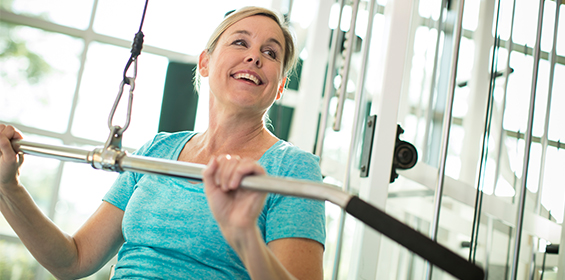Aging is a part of life; bone disease and fractures (broken bones) need not be. Although some risk factors of osteoporosis (decreased bone density) cannot be controlled such as family history, small stature and gender (White and Asian females are at highest risk), focusing on prevention and lifestyle changes may significantly reduce your future risk of osteoporosis and fractures. You can also decrease your risk of disability as you age gracefully.
Bones provide a structural framework for our bodies to perform all activities. They also protect our vital organs, such as brain, heart and lungs. Ways to increase bone health and minimize risk of fracture include adequate nutrition, exercise, avoiding nicotine, and minimizing the risk of falls.
Nutrition
- Consume adequate calcium (1000-1500 mg per day). The requirement is different for each age group. The requirement is highest for teens and adults over 50 at the equivalent of four 8-oz glasses of milk per day. An average adult needs the equivalent of three 8-oz glasses of milk per day. Fortified juice and cereals, green leafy vegetables, sardines, tofu and yogurt also provide excellent dietary sources of calcium. Remember absorption occurs best when calcium intake is spread throughout the day.
- Consume adequate vitamin D. The requirement for vitamin D increases as we age. Our bodies produce vitamin D from sunlight. Seniors who do not get much sunlight may need to use supplements to obtain enough vitamin D. Dietary sources of vitamin D are wild caught salmon, cod liver oil, canned tuna, egg yolks and many fortified foods (juice, soy milk, cereals).
- Limit alcohol intake to two or less drinks per day. Excessive alcohol use may weaken bone by increasing levels of cortisol and parathyroid hormone. This is especially true in adolescents and young adults.
- Limit caffeine intake to three or less drinks per day. Caffeine is also suspected to weaken bone although this is easily offset by good dietary intake.
Exercise
- Bones increase their strength/density with regular weight-bearing and strength-training exercise. Activities include walking, tennis, dance, jogging, and weight lifting. It appears that resistance exercise (weight lifting) has the most profound effect on increasing bone mineral density. Exercise at least 30 minutes daily.
Do Not Smoke
- Nicotine is known to weaken bones and interfere with healing. It can decrease absorption of dietary calcium and inhibit production of bone producing cells (osteoblasts). Smokers also have reduced blood flow to the bones which delays fracture and surgical healing.
Prevent Falls in the Elderly
- Remove small rugs or other objects that may cause tripping, and maintain adequate lighting throughout your home. Wear supportive non-slip shoes. Begin exercises that train the nervous system to improve coordination and balance such as dancing, yoga or pilates.
By following the recommendations listed, you may reduce your risk of a fracture. Keep your bones healthy and you can spend your time and money on something you enjoy rather than treating a preventable fracture resulting from a weakened skeletal system.
Reference: US Dept of Health & Human Services. Bone Health & Osteoporosis: A Report of the Surgeon General. Rockville, MD: US Dept of Health & Human Services, Office of the Surgeon General, 2004

